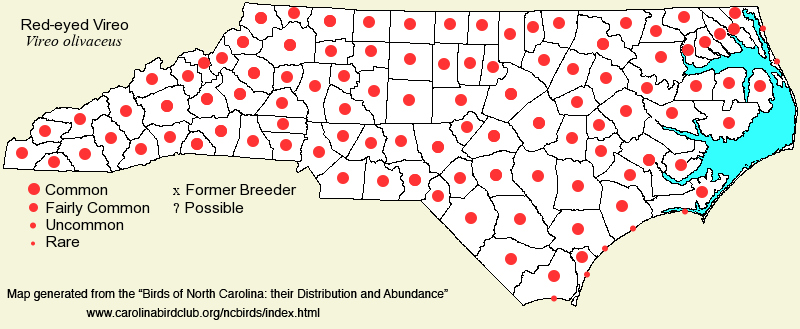 |  |
|
Red-eyed Vireo - Vireo olivaceus VIREONIDAE Members: | Search Common: Search Scientific: |
|
|
|||||||
| General Comments | The Red-eyed Vireo is the most common breeding bird of the Eastern deciduous forest, and this commentary was just as true 50 years ago as it is today. It breeds over the entirety of the state, though it may be absent on a few coastal islands. It is practically impossible to miss in an hour of birding in any hardwood or mixed forest across the state from late April through June. It favors middle-aged to mature hardwood forests, somewhat preferring mesic and moist forests, such as bottomlands (less so in swamps), over dry forests; it also is found in the hardwood understory of pine forests. There is just one winter record for the state. | ||||||
| Breeding Status | Breeder | ||||||
| NC BRC List | Definitive | ||||||
| State Status | |||||||
| U.S. Status | |||||||
| State Rank | S5B | ||||||
| Global Rank | G5 | ||||||
| Coastal Plain | Summer resident. Very common over most of the province, though less numerous close to the coast, and not common in some forests on the Outer Banks. Mainly early or mid-Apr to mid-Oct. Extremely late was one photographed at Airlie Gardens (New Hanover) from 22-26 Nov 2024. Peak counts: 350 migrants seen and noted in flight over Run Hill State Natural Area (Dare) on 23 Sep 2020. | ||||||
| Piedmont | Summer resident. Very common across the region. Mainly mid-Apr to mid-Oct. The only known winter report for the state was a lingering bird photographed at Mason Farm Biological Reserve (Orange) on 3 Dec 2012 [Chat 77:60 link]. Peak counts: | ||||||
| Mountains | Summer resident. Very common at lower to middle elevations, up to 4,000 feet; less numerous to about 5,000 feet. Mainly mid-Apr to mid-Oct. Peak counts: | ||||||
| Finding Tips |
No tips needed. **** | ||||||
| Attribution | LeGrand[2025-02-04], LeGrand[2023-03-26], LeGrand[2021-03-06] | ||||||
| NC Map Map depicts all counties with a report (transient or resident) for the species. | Click on county for list of all known species. |
| NC Breeding Season Map Map depicts assumed breeding season abundance for the species. |  |